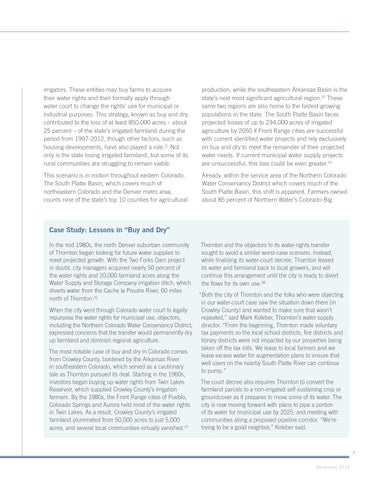irrigators. These entities may buy farms to acquire their water rights and then formally apply through water court to change the rights’ use for municipal or industrial purposes. This strategy, known as buy and dry, contributed to the loss of at least 850,000 acres – about 25 percent – of the state’s irrigated farmland during the period from 1997-2012, though other factors, such as housing developments, have also played a role.21 Not only is the state losing irrigated farmland, but some of its rural communities are struggling to remain viable.
production, while the southeastern Arkansas Basin is the state’s next most significant agricultural region.22 These same two regions are also home to the fastest-growing populations in the state. The South Platte Basin faces projected losses of up to 234,000 acres of irrigated agriculture by 2050 if Front Range cities are successful with current identified water projects and rely exclusively on buy and dry to meet the remainder of their projected water needs. If current municipal water supply projects are unsuccessful, this loss could be even greater.23
This scenario is in motion throughout eastern Colorado. The South Platte Basin, which covers much of northeastern Colorado and the Denver metro area, counts nine of the state’s top 10 counties for agricultural
Already, within the service area of the Northern Colorado Water Conservancy District which covers much of the South Platte Basin, this shift is apparent. Farmers owned about 85 percent of Northern Water’s Colorado-Big
Case Study: Lessons in “Buy and Dry” In the mid 1980s, the north Denver suburban community of Thornton began looking for future water supplies to meet projected growth. With the Two Forks Dam project in doubt, city managers acquired nearly 50 percent of the water rights and 20,000 farmland acres along the Water Supply and Storage Company irrigation ditch, which diverts water from the Cache la Poudre River, 60 miles north of Thornton.26 When the city went through Colorado water court to legally repurpose the water rights for municipal use, objectors, including the Northern Colorado Water Conservancy District, expressed concerns that the transfer would permanently dry up farmland and diminish regional agriculture. The most notable case of buy and dry in Colorado comes from Crowley County, bordered by the Arkansas River in southeastern Colorado, which served as a cautionary tale as Thornton pursued its deal. Starting in the 1960s, investors began buying up water rights from Twin Lakes Reservoir, which supplied Crowley County’s irrigation farmers. By the 1980s, the Front Range cities of Pueblo, Colorado Springs and Aurora held most of the water rights in Twin Lakes. As a result, Crowley County’s irrigated farmland plummeted from 50,000 acres to just 5,000 acres, and several local communities virtually vanished.27
Thornton and the objectors to its water-rights transfer sought to avoid a similar worst-case scenario. Instead, while finalizing its water-court decree, Thornton leased its water and farmland back to local growers, and will continue this arrangement until the city is ready to divert the flows for its own use.28 “Both the city of Thornton and the folks who were objecting in our water-court case saw the situation down there [in Crowley County] and wanted to make sure that wasn’t repeated,” said Mark Koleber, Thornton’s water supply director. “From the beginning, Thornton made voluntary tax payments so the local school districts, fire districts and library districts were not impacted by our properties being taken off the tax rolls. We lease to local farmers and we lease excess water for augmentation plans to ensure that well users on the nearby South Platte River can continue to pump.” The court decree also requires Thornton to convert the farmland parcels to a non-irrigated self-sustaining crop or groundcover as it prepares to move some of its water. The city is now moving forward with plans to pipe a portion of its water for municipal use by 2025, and meeting with communities along a proposed pipeline corridor. “We’re trying to be a good neighbor,” Koleber said.
7 December 2015
